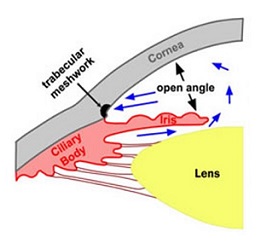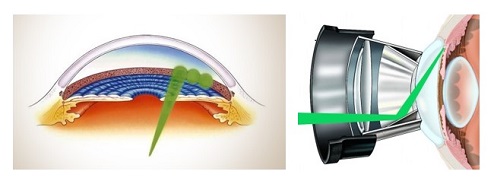Why is selective laser trabeculoplasty necessary?
Selective laser trabeculoplasty or SLT is a laser procedure performed for patients with glaucoma or high eye pressure.

Fluid in the eye (aqueous) is produced by the ciliary body, and drains out through the trabecular meshwork (drainage pathway). Sometimes the meshwork no longer copes, thus preventing the aqueous from draining out. This causes pressure to build up in the eye. When the pressure is too high, it causes damage to the optic nerve and permanent vision loss – this is called glaucoma.
Selective laser trabeculoplasty is often performed as first-line treatment for glaucoma and high eye pressure, thus avoiding the side effects and inconvenience of using eye drops daily on a long-term basis. The laser is very safe and can be repeated without causing any damage to the eye.
See Related: Medical treatments for glaucoma
What does selective laser trabeculoplasty do?
How the laser works precisely is unclear. What is known is that the laser stimulates the cells and tissues in the trabecular meshwork to work harder to drain aqueous out from the eye. This “unclogs the guttering” and helps to reduce the eye pressure. The pressure-lowering effect of the laser is not immediate, and can take up to 4 to 8 weeks to become apparent.
If selective laser trabeculoplasty does not work initially (approximately 20% do not succeed the first time), a second treatment often does.
Please note that the pressure-lowering effect of the laser is not permanent, and can last from 6 months to 2 years plus. Generally, the effect is maintained for about a year with each treatment. As selective laser trabeculoplasty is very safe, it can be repeated multiple times as necessary.
Please note also that selective laser trabeculoplasty is not laser vision correction and therefore does not improve your vision.
See Related: Laser treatments for glaucoma
What are the potential risks?
SLT is a very safe procedure. Complications are usually mild and do not result in any permanent damage. These include:
● Scratch on the front window of the eye (cornea)
● Inflammation in the eye
● High pressure in the eye
● Discomfort inside the eyeball
What should I expect?
SLT is an office-based procedure, and does not require sedation or hospital admission. Both eyes will usually require treatment, but not on the same day..
Before laser:
On the day of your procedure, please take all your usual medications unless otherwise advised. You will not be able to drive home on the day of the procedure, so you will need to arrange for someone to take you home. Please allow at least 2 hours.
Before the laser procedure, 3 types of eye drops will be put in the eye undergoing laser:
● Pilocarpine to constrict the pupil. This can take up to 30 minutes to work.
● Brimonidine to reduce the risk of eye pressure spikes following laser
● Local anaesthetic to numb the eye
Please note that pilocarpine blurs the vision and can cause a headache. This may last a few hours.

During laser:
SLT is performed with the patient seated at the laser machine. The laser is delivered through a special contact lens that is placed on the eye. You may feel some mild discomfort with each laser shot. The laser itself takes only a few minutes to perform and is completed once half of the trabecular meshwork has received laser treatment.
After laser:
Most patients can go home immediately after laser. However, in certain situations, you may need to stay for 30 to 60 minutes to recheck your eye pressure before you go home. You may be able to discontinue your usual glaucoma eye drops (if any) after laser treatment.
Usually, no eye drops are required after laser. However, if there is inflammation after laser, you may be given a steroid anti-inflammatory eye drop (usually Fluorometholone) to use 3 times daily for 1 week. If your eye pressure is high after laser, you may be given additional pressure lowering medications, either as eye drops or tablets.
Over the next few days, you may experience some blurriness, irritation, and sensitivity to light. This will gradually improve without any treatment.
Recovery can sometimes take a few days, but you can go back to work the next day if you wish.
You will usually be reviewed 4 to 6 weeks after SLT.
See Related:



